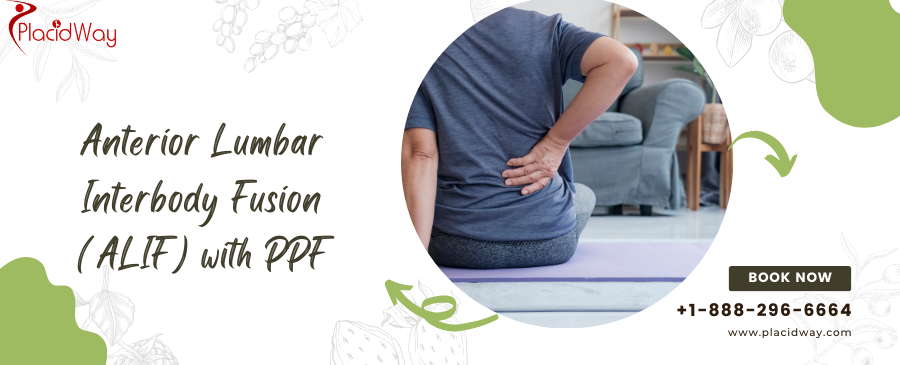
Finding Lasting Relief: Understanding ALIF with PPF for Back Pain
Living with chronic lower back pain or leg discomfort can be debilitating, affecting every aspect of your life—from daily activities to your overall well-being. If you've explored conservative treatments without success, and conditions like degenerative disc disease, spinal stenosis, or spondylolisthesis are significantly impacting your mobility and comfort, you might be looking for more definitive solutions. You're likely searching for "spinal fusion surgery options," "best treatment for lower back pain," or "what is ALIF surgery?". You're not alone in seeking answers, and advanced procedures like Anterior Lumbar Interbody Fusion (ALIF) with Posterior Pedicle Fixation (PPF) offer a path towards regaining a pain-free life.
ALIF with PPF is a highly effective surgical approach designed to stabilize the lumbar spine and alleviate nerve compression. This procedure combines two powerful techniques: ALIF, which involves accessing the spine from the front (abdomen) to remove a damaged disc and insert a bone graft, and PPF, which adds stability by securing rods and screws from the back of the spine. The dual approach provides robust support, promoting solid fusion and long-term relief from symptoms like sciatica, numbness, and severe back pain. For many, especially those considering medical travel, understanding this comprehensive procedure is the first step toward a brighter, more active future.
Let's delve into what ALIF with PPF entails, who can benefit, what to expect, and how medical tourism can make this life-changing surgery more accessible.
What symptoms suggest you might need ALIF with PPF?
Patients considering ALIF with PPF typically experience a range of symptoms that significantly impair their quality of life. These often stem from conditions that affect the stability and health of the lumbar (lower) spine. Common symptoms include:
- Chronic Lower Back Pain: A deep, aching pain in the lower back that persists for more than 12 weeks, often worsening with activity and finding little relief with rest. Patients often search for "constant lower back pain relief" or "what causes debilitating back pain."
- Radicular Pain (Sciatica): Pain that radiates from the lower back down one or both legs, often described as sharp, burning, or shooting. This can be accompanied by numbness, tingling, or weakness in the leg or foot, indicating nerve compression. Many patients look for "sciatica leg pain treatment" or "nerve pain in leg from back."
- Spinal Instability: A feeling of the back "giving out" or sharp, sudden pain with certain movements. This can be due to a slipped vertebra (spondylolisthesis) or advanced disc degeneration.
- Loss of Mobility: Difficulty bending, twisting, or standing for prolonged periods due to pain and stiffness.
- Numbness or Weakness: Persistent numbness, tingling, or weakness in the legs or feet, which can impact walking and balance.
These symptoms usually don't respond adequately to non-surgical treatments like physical therapy, medication, or injections, leading patients to explore surgical options.
What causes spinal conditions that require ALIF with PPF?
The need for ALIF with PPF arises from several underlying spinal conditions, most of which involve the deterioration or instability of the vertebral discs and bones in the lumbar region. Understanding these causes helps pinpoint why this specific fusion technique is recommended:
- Degenerative Disc Disease (DDD): This is the most common cause. As we age, the discs between our vertebrae can lose hydration, flatten, and crack, leading to pain, instability, and sometimes nerve compression. Patients often search for "disc degeneration treatment options" or "worn out spinal discs."
- Spondylolisthesis: A condition where one vertebra slips forward over the one below it. This can pinch nerves and cause significant pain and instability. People look for "slipped disc surgery" or "vertebra displacement treatment."
- Spinal Stenosis: The narrowing of the spinal canal, which puts pressure on the spinal cord and nerves. While often treated with decompression alone, if instability is present, fusion might be necessary.
- Spinal Deformities: Conditions like scoliosis or kyphosis that cause abnormal curvature of the spine, leading to pain and functional limitations. ALIF with PPF can correct deformities and stabilize the spine.
- Post-Laminectomy Syndrome: Persistent pain after previous back surgery, potentially due to continued instability.
- Spinal Fractures: In some cases, fractures that lead to instability may require fusion.
Risk factors contributing to these conditions include aging, genetics, repetitive stress on the spine, obesity, smoking, and a sedentary lifestyle.
How does Anterior Lumbar Interbody Fusion (ALIF) with PPF work?
ALIF with PPF is a sophisticated spinal stabilization procedure that tackles both the front and back of the spine for comprehensive support and fusion. Here’s a simplified breakdown:
- Anterior Lumbar Interbody Fusion (ALIF):
- Access: The surgeon makes an incision in the abdomen and gently moves abdominal muscles and organs aside to access the front of the lumbar spine. This anterior approach avoids cutting through major back muscles, often leading to less post-operative pain and quicker recovery of muscle function.
- Disc Removal and Graft Insertion: The damaged intervertebral disc is carefully removed. A cage (usually made of PEEK or titanium) packed with bone graft material (either from the patient, a donor, or synthetic) is then inserted into the disc space. This restores disc height, decompresses nerves, and provides a scaffold for new bone growth.
- Posterior Pedicle Fixation (PPF):
- Access: This typically involves a separate, smaller incision in the back.
- Stabilization: Pedicle screws are placed into the vertebrae above and below the fused segment. These screws are then connected by rods, providing immediate stability to the spine while the bone graft fuses. This posterior fixation enhances the fusion rate and prevents movement, which is crucial for successful long-term outcomes.
The combination of ALIF and PPF ensures that the spine is stabilized from both the front and back, creating a robust environment for fusion. Over several months, the bone graft material in the cage grows and solidifies, permanently joining the two vertebrae into a single, stable bone segment. This fusion eliminates motion at the painful segment, thereby relieving nerve compression and instability.
Who is an ideal candidate for ALIF with PPF?
Deciding on spinal surgery is a significant step, and not everyone with back pain is a candidate for ALIF with PPF. Ideal candidates generally fit these criteria:
- Diagnosis: A clear diagnosis of a condition like severe degenerative disc disease, spondylolisthesis (spinal slippage), spinal stenosis, or a spinal deformity causing instability and nerve compression in the lumbar spine.
- Failed Conservative Treatments: The patient has undergone at least 6-12 months of non-surgical treatments (physical therapy, medication, injections, chiropractic care) without significant, lasting relief.
- Symptoms Correlate with Imaging: Clinical symptoms of pain, numbness, or weakness precisely match findings on diagnostic imaging (MRI, CT scan, X-rays).
- Overall Health: Good general health, without severe underlying medical conditions that would significantly increase surgical risks. Candidates should be non-smokers or willing to quit, as smoking can impair bone fusion.
- Realistic Expectations: Understanding of the procedure, potential risks, recovery process, and realistic expectations regarding outcomes.
A thorough evaluation by a spinal surgeon, including a physical examination and review of medical history and imaging, is crucial to determine suitability.
What can you expect during the recovery period after ALIF with PPF?
Recovery from ALIF with PPF is a gradual process that requires patience and adherence to post-operative instructions. While initial relief from nerve pain can be immediate, the full benefits of fusion take time. Here’s a general timeline:
- Hospital Stay (2-5 days): Immediately after surgery, you'll be monitored for pain management, wound care, and early mobilization. You'll likely begin gentle walking the day after surgery.
- First 2-6 Weeks (Early Recovery):
- Pain will be managed with medication.
- Activity will be restricted to light movements, short walks, and avoiding bending, twisting, or lifting.
- Some patients may wear a brace for support.
- Patients often ask, "How soon can I walk after ALIF?" — usually within days with assistance.
- 2-6 Months (Intermediate Recovery & Physical Therapy):
- Physical therapy typically begins to strengthen core muscles, improve flexibility, and restore proper movement patterns.
- Gradual increase in activity levels as tolerated.
- Many patients wonder, "When can I return to work after spinal fusion?" — light-duty work might be possible at 6-8 weeks, with physically demanding jobs taking 3-6 months or longer.
- 6-12+ Months (Full Fusion & Long-Term Recovery):
- Bone fusion continues to solidify.
- Most significant pain relief and functional improvements are usually experienced during this period.
- Return to most normal activities, including light sports, with surgeon's clearance.
It's crucial to follow your surgeon's guidance, avoid activities that stress the fusion, and participate actively in physical therapy for the best possible outcome. "What is ALIF recovery like?" is a common question, and it's a journey of gradual progress and commitment.
What are the potential risks and side effects of ALIF with PPF?
While ALIF with PPF is generally safe and highly effective, it's a major surgical procedure and comes with potential risks and side effects that patients should be aware of:
- General Surgical Risks:
- Infection: At the incision site or deeper in the spine.
- Bleeding: During or after surgery.
- Anesthesia Reactions: Adverse reactions to anesthetic agents.
- Blood Clots: In the legs (DVT) which can travel to the lungs (PE).
- Spinal Fusion Specific Risks:
- Non-Fusion (Pseudarthrosis): The bone graft fails to fuse properly, requiring potential revision surgery. This is a common concern when patients search for "failed back surgery syndrome."
- Hardware Failure: Screws or rods can break or loosen.
- Nerve Damage: Resulting in weakness, numbness, or increased pain.
- Adjacent Segment Disease: Increased stress on discs above or below the fused segment, leading to degeneration over time.
- ALIF Specific Risks (due to anterior approach):
- Vascular Injury: Damage to major blood vessels (aorta, vena cava) near the spine.
- Bowel or Ureter Injury: Though rare, damage to abdominal organs.
- Retrograde Ejaculation (in males): Temporary or permanent condition where semen enters the bladder instead of exiting the body. This is a specific concern related to nerve disruption during the anterior approach.
- Hernia: At the incision site.
- Persistent Pain: Despite successful fusion, some patients may still experience chronic pain, often when researching "ALIF not working" or "pain after fusion surgery."
Your surgeon will discuss these risks in detail and take precautions to minimize them. Choosing an experienced surgeon and facility greatly reduces these possibilities.
How much does ALIF with PPF typically cost globally?
The financial aspect of advanced spinal surgery like ALIF with PPF is a major consideration for many patients. Costs can fluctuate dramatically based on geographic location, the healthcare system, the surgeon's expertise, hospital fees, implant costs, and the duration of the hospital stay. This variation is a primary driver for medical tourism, with patients seeking high-quality care at a more affordable price.
Worldwide Cost Comparison for ALIF with PPF (Estimated Ranges)
| Country | Estimated Cost Range (USD) | Notes |
|---|---|---|
| United States | $60,000 - $150,000+ | Highest costs, varies widely by state and facility. Often covered by insurance. |
| Canada | $50,000 - $100,000+ | Similar to US without public health coverage. |
| Mexico | $20,000 - $45,000 | Popular for medical tourism, significantly lower costs. |
| Costa Rica | $18,000 - $40,000 | Known for quality care at competitive prices. |
| Turkey | $15,000 - $35,000 | Emerging medical tourism hub with modern facilities. |
| India | $12,000 - $30,000 | Very competitive pricing with high-volume hospitals. |
| Thailand | $18,000 - $40,000 | Excellent patient services and quality hospitals. |
| South Korea | $25,000 - $50,000 | Advanced technology and highly skilled surgeons. |
Disclaimer: These are approximate ranges and can vary based on the specific case, surgeon's fees, hospital amenities, length of stay, and additional services. It's always best to get a personalized quote.
When searching for "ALIF surgery cost abroad" or "affordable spinal fusion overseas," patients often find that savings can be substantial, even after factoring in travel and accommodation. This makes medical tourism a viable option for many who cannot afford care in their home country or face long waiting lists.
Why should you consider ALIF with PPF surgery abroad?
Many individuals grappling with severe back pain and the need for advanced spinal surgery are increasingly looking beyond their borders. The decision to pursue ALIF with PPF surgery abroad is often driven by compelling factors:
- Cost-Effectiveness: As seen in the cost comparison, the most prominent advantage is the dramatic reduction in price without compromising quality. This makes life-changing surgery accessible to those without adequate insurance or facing prohibitive costs at home. Patients often ask, "Is spinal fusion cheaper in Mexico?" or "Where is ALIF surgery affordable?"
- Access to Specialists and Technology: Leading medical tourism destinations boast world-renowned spine surgeons who perform ALIF with PPF regularly, often using the latest surgical techniques and advanced diagnostic equipment, sometimes even more advanced than what's available locally.
- Reduced Wait Times: In countries with universal healthcare systems, waiting lists for elective surgeries can be long, delaying crucial treatment. Going abroad can mean getting the surgery sooner and starting recovery sooner.
- Privacy and Comfort: Medical tourism often provides a more private, discreet experience with personalized care, luxurious recovery facilities, and dedicated patient coordinators, making the journey less stressful.
- Integrated Care Packages: Many international hospitals offer all-inclusive packages covering surgery, hospital stay, post-operative care, and sometimes even accommodation and airport transfers, simplifying the travel process for patients searching "spinal fusion abroad packages."
For those seeking "best value spinal surgery" or "high-quality spine treatment overseas," medical tourism presents a compelling solution.
Which countries offer high-quality ALIF with PPF at a good value?
When searching for "best hospitals for ALIF overseas" or "top spine surgeons abroad," certain countries consistently stand out for offering excellent medical care at a fraction of the cost found in the US or Western Europe:
- Mexico: Proximity to the US makes it a popular choice. Cities like Tijuana, Cancun, and Guadalajara have internationally accredited hospitals with highly skilled neurosurgeons and orthopedic spine surgeons. "Spinal fusion in Mexico reviews" often highlight the affordability and quality.
- Costa Rica: Known for its beautiful environment and high-standard medical facilities, Costa Rica offers modern hospitals and US-trained surgeons, particularly in San Jose.
- Turkey: An increasingly popular destination in Europe and Asia, Turkey boasts state-of-the-art hospitals, often with English-speaking staff, and competitive pricing for complex procedures like ALIF with PPF.
- India: A powerhouse in medical tourism, India offers highly advanced medical infrastructure, a vast pool of experienced spine specialists, and exceptionally low costs for procedures, attracting patients globally. "ALIF surgery in India cost" is a frequent search query.
- Thailand: Combining world-class medical facilities with renowned hospitality, Thailand provides excellent care in a comfortable, vacation-like setting, especially in cities like Bangkok.
- South Korea: While slightly higher in cost than some other Asian destinations, South Korea offers cutting-edge technology and highly specialized surgeons, making it attractive for complex spinal cases.
These countries invest heavily in their medical infrastructure, ensuring that patients receive care comparable to or exceeding what they might find in their home countries, especially for procedures like ALIF with PPF. They understand the "medical tourist experience" and often have dedicated international patient departments.
How can you ensure safety and quality when getting ALIF with PPF overseas?
Ensuring safety and quality is paramount when considering any surgery abroad, especially one as critical as ALIF with PPF. Here's how you can minimize risks and maximize the chances of a positive outcome:
- Choose Internationally Accredited Hospitals: Look for hospitals with international accreditations, such as those from the Joint Commission International (JCI). This signifies that the facility meets rigorous global standards for patient care and safety. Patients often search for "JCI accredited hospitals for spine surgery."
- Verify Surgeon Credentials and Experience: Research your surgeon's qualifications, board certifications, number of ALIF with PPF procedures performed, and any international fellowships. Don't hesitate to ask for their success rates and complication rates. Ensure they specialize in spine surgery.
- Utilize Reputable Medical Tourism Facilitators: Companies like PlacidWay specialize in connecting patients with trusted, high-quality international providers. They can help with vetting hospitals, arranging consultations, travel logistics, and providing support throughout your journey, acting as a crucial bridge for those researching "medical travel for spine surgery."
- Review Patient Testimonials and Success Stories: Look for reviews, testimonials, and patient success stories specific to ALIF with PPF. Hearing from others who have gone through the process can provide valuable insights and reassurance.
- Clear Communication: Ensure there are clear communication channels with your medical team, including access to interpreters if needed. Understanding your pre-operative instructions, the procedure itself, and post-operative care is vital.
- Post-Operative Care Plan: Discuss and confirm the post-operative care plan, including physical therapy, follow-up appointments, and how your local doctors can coordinate with the overseas team.
- Understand the All-Inclusive Package: Clarify what your quoted price includes (hospital stay, surgeon fees, anesthesia, implants, medications, physical therapy, accommodation, etc.) to avoid hidden costs.
By taking these proactive steps, you can confidently pursue ALIF with PPF abroad, knowing you've prioritized your safety and the quality of your care. Many international hospitals also have dedicated international patient departments equipped to handle all aspects of your medical journey, including visa assistance and accommodation, easing the stress of "traveling for medical treatment."
Take the Next Step with PlacidWay
Ready to explore treatment options abroad? Discover top clinics, compare prices, and get a free quote tailored to your needs with PlacidWay.
Affordable Spine Surgery | Best Spine Surgery Abroad





.png)
.png)
.png)
.png)

Share this listing